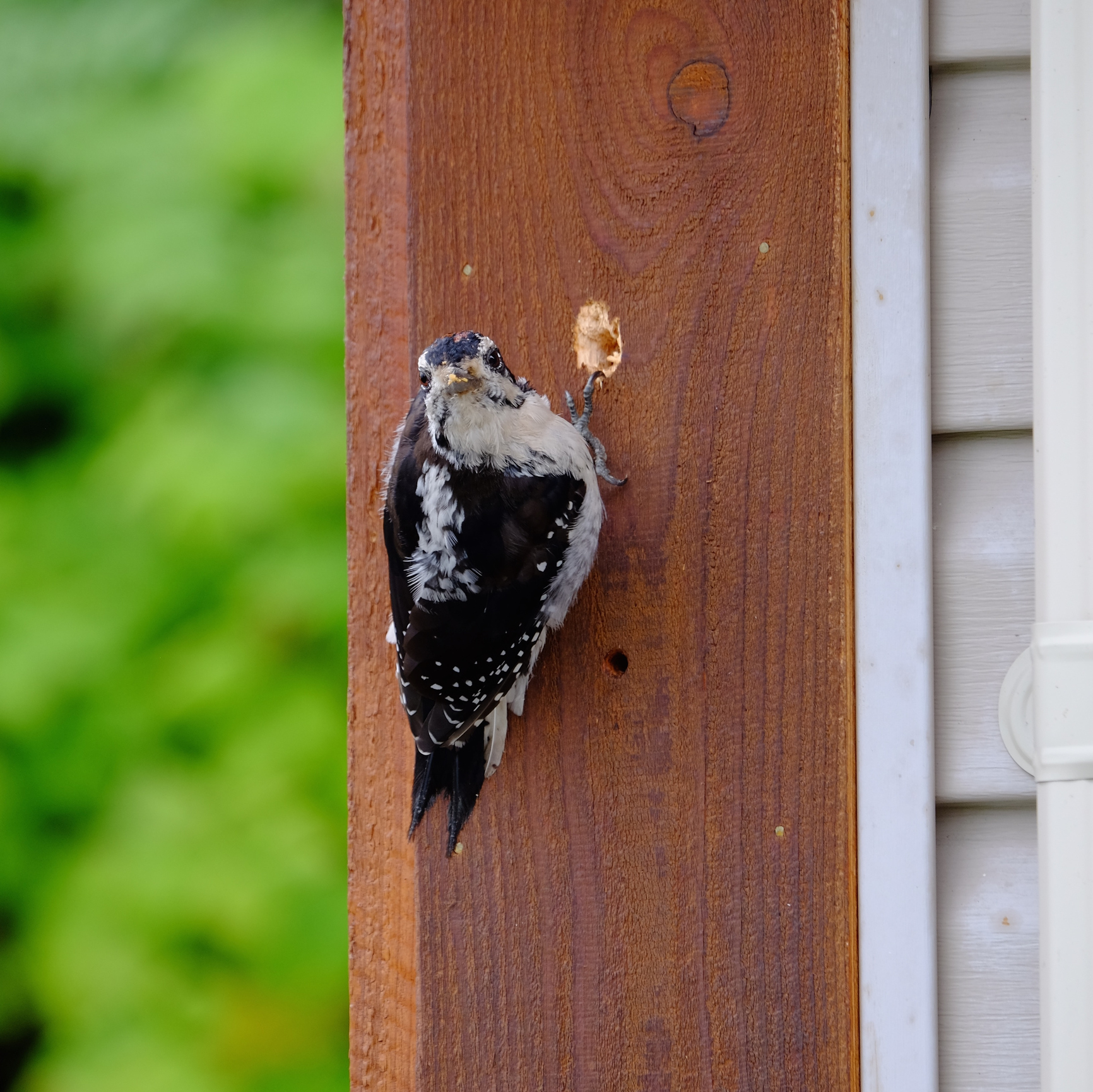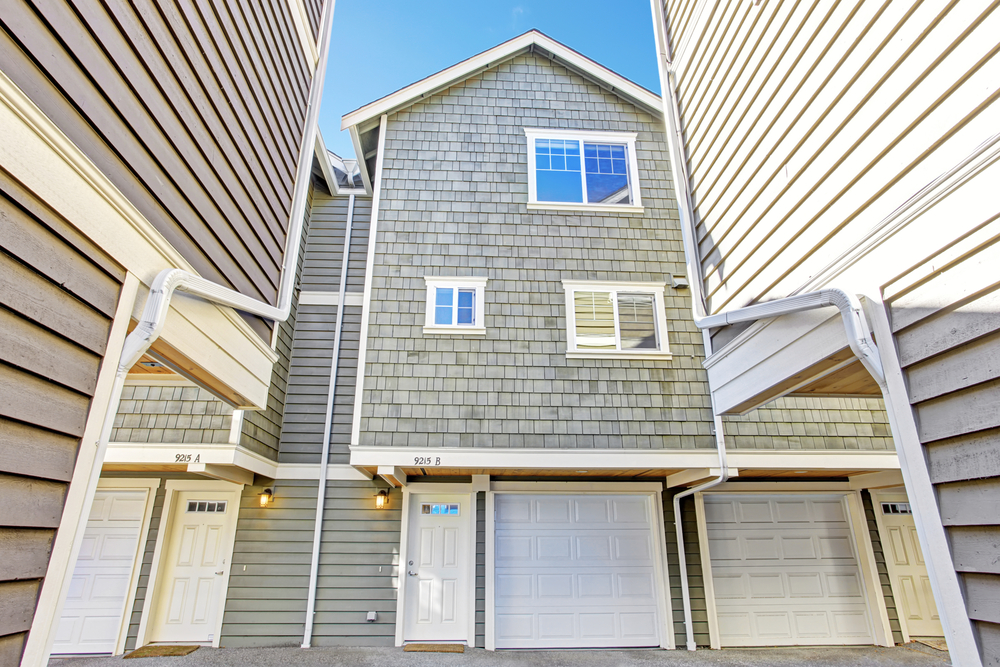The Best Way to Side Your Wood House
Tap, tap, tap. That's the audio of your siding beingness destroyed. Woodpeckers and insects can create massive problems in a habitation with wood siding—ranging all the style from aesthetic flaws and defects to huge structural problems that threaten the prophylactic of your home.
Nonetheless, you lot don't have to passively have whatever damage these invaders wreak on your home. In that location are many ways to defeat woods pests—and even some things y'all tin can practice to forbid problems before they even begin.

Table of Contents
- The Most Common Pests for Wood Siding—and How to Handle Them
- Rundown Gutters and Downspouts Can Concenter Pests
- Keep Soil and Firewood Away from Your Siding to Avoid Infestations
- Go with Vinyl, Fiber Cement, or Aluminum Siding When Y'all Remodel
The Almost Common Pests for Woods Siding—and How to Handle Them
The most disastrous issues come from pests that burrow into forest siding, destroying the effectiveness and aesthetic advent of your siding. Here'southward how to spot the virtually common invaders, and what your next movement should exist when you see them.
- Termites. Subterranean termites alive underground, feeding on wood surfaces buried below the surface. When they've expended those food sources, they often create "feeder tubes"—hollow channels in your siding that destroy the structural integrity of the wood. Because these tubes are hidden nether the surface of the siding, they've ofttimes difficult to spot before it'south as well late. However, a expert way to test for infestations is to tap the siding with a screwdriver—a hollow sound indicates a possible problem. Termites crusade such serious damage that you'll generally need to engage a professional pest management service to get rid of them. The exterminator volition typically bait the soil surrounding your home with organophosphate and pyrethroid insecticides.
- Carpenter ants. Carpenter ants often favor insulation and inner walls simply will make their mode outward to siding every bit their colony expands. They typically adopt moist, rotting woods, and so their presence can betoken a problem with decaying walls, likewise. Signs of an infestation include small piles of forest shavings produced as worker ants tunnel into the surface of the wood. You lot also might see the ants themselves—they're pocket-sized and black-colored and produce winged swarms during the warmer weather. You can diagnose bug with carpenter ants yourself—insecticide baits for the nests tin can exist bought at a home goods store. It will likewise pay to do some inspections of your attic vents and foundation—as well equally around openings in your outer envelope and roof for pipes, chimney, and vents since these sites are common spots for nests. All the same, if the problem is expansive, it never hurts to hire a professional person who can seek out nests for you.
- Pulverization post beetles. Powder post beetles live within the wood, feeding on the starches in the woods fibers until they reach maturity. At that point, they tunnel back outside to the exterior of the wood, leaving fine sawdust and tiny sets of holes in their wake. The well-nigh noticeable evidence of a beetle problem is the advent of modest go out holes—they perforate wood surfaces with tiny openings, making it look similar a sponge. If it's dusted with a fine powder that resembles flour, that'south a dead giveaway that you have a protrude trouble. The best way to handle beetle infestations is to cut off their moisture, which you lot can do past following the tips listed in the next sections. Spraying a wood preservative treatment onto the surface will also help, although non if the forest on your home is stained. You can likewise take a pest exterminator fumigate your home or apply a pesticide into the interior of your siding using a forest injector.
- Carpenter bees. These small nuisance pests resemble bumblebees, but they're far more damaging to your home. They tunnel into wood to create nests, which they reuse flavour later on flavour. The practiced news is that carpenter bees are pretty piece of cake to defeat. To destroy the nests, make full the holes with insecticide, and then plug them with appropriate exterior caulking.
- Woodpeckers. Woodpeckers usually denote their presence with their notorious tapping, and they're pretty easy to catch in the deed. Woodpeckers unremarkably attempt to drill into corners where ii pieces of siding join—you'll see the damage as smallish holes running along the edges. They particularly honey homes covered in cedar shakes. To get rid of them the humane mode, you lot tin attach shiny materials or electronic deterrents to the side of your dwelling house—that makes your siding less appealing to woodpecker colonies. Or you tin can ready a woodpecker feeder or birdhouse, which will give them an alternative place to nest.
Rundown Gutters and Downspouts Can Concenter Pests
Yeah, your home's exterior is congenital to withstand rainstorms and other weather condition. But standing water and constant moisture can cause real problems. Moisture causes forest rot, and pests just dearest to burrow into decomposable wood surfaces—and of grade, the wood rot itself poses a major business for the structural integrity of your walls and siding. One of the best means to avoid issues with dampness in your siding is to keep your home's drainage system intact and functioning.
That means cleaning your gutters frequently—at least twice a year—so that they don't become backed upwardly and allow water to spill over onto your siding. Audit your downspouts regularly, as well, since damaged pieces tin direct runoff onto your walls and into the footing surrounding your habitation. Downspouts should take an elbow piece attached to the terminate that pushes rainwater away from your home.

Keep Soil and Firewood Abroad from Your Siding to Avert Infestations
There's a reason homes take foundations. Beyond just supporting the walls, a practiced foundation works to insulate your home and keep it dry and pest-costless, too. Your foundation protects your siding from excess wet in the basis so it tin keep doing its chore, just over time, erosion and the furnishings of weather can cause soil to build up against your walls. Pests mostly come from below, and then if your wood siding is affluent against the basis, there's a greater take a chance for damage from wet and the resulting insect infestations. If soil, overgrowth, or mulch have completely covered your foundation, you'll need to dig yourself out to avoid future problems.
Similarly, firewood stacked against the side of a dwelling creates an opportunity for pests, as well. Forest-irksome insects love to make homes in stacks of unseasoned wood, and since information technology'due south in contact with the ground and your siding, it makes a perfect bridge for pests to get into your siding. Motility firewood a few feet away from your home, and you can avoid the majority of problems here.
Go with Vinyl, Fiber Cement, or Aluminum Siding When You Remodel
Insects tin't destroy your forest siding if yous don't take whatever in the first place. Vinyl, cobweb cement, and aluminum siding all offer greater immovability than woods—and fewer issues with rot and moisture, besides. Textured vinyl panels have come a long manner in contempo years and now closely resemble the pattern and grain of real woods. However, if you really crave the appearance of authentic lumber, cobweb cement offers a nice alternative—it's made upward of natural wood fibers molded into cement, which helps it reach the natural texture of wood. Have care to shore up any issues with runoff, though: insects can all the same threaten the forest backside the siding if the conditions are correct. Proper maintenance is always your best defense against pests!
Source: https://modernize.com/homeowner-resources/siding/pests-create-problems-siding
Enregistrer un commentaire for "The Best Way to Side Your Wood House"